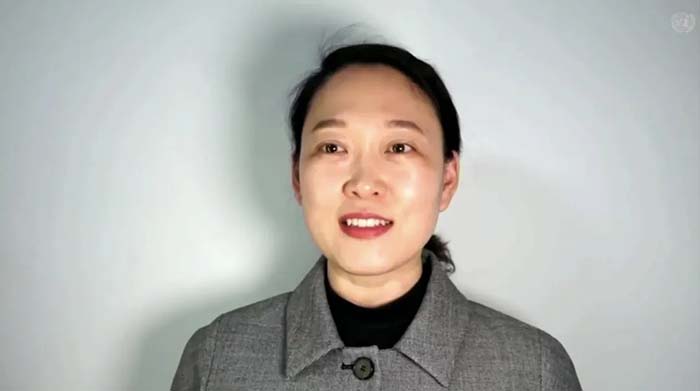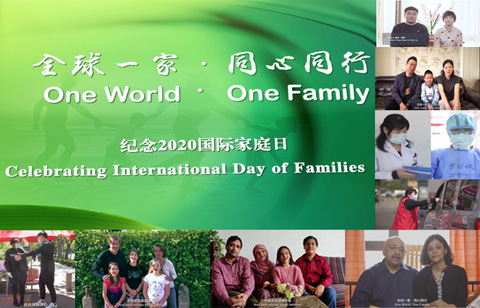Global Efforts in Building Child-Friendly Cities
Date:2021-8-31 14:45:25 Views: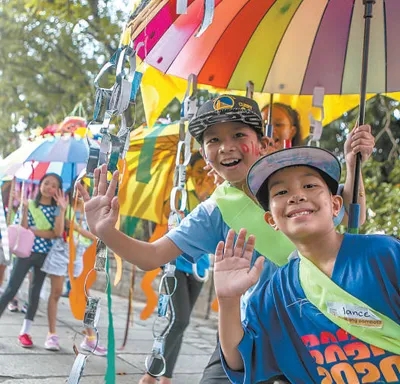
Children in costumes made of renewable materials participate in the "Children Parade" in Manila, the Philippines. [Xinhua]
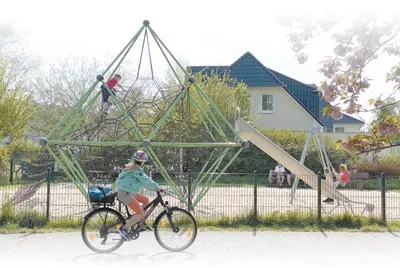
Children have fun in a playground in Berlin, Germany. [Xinhua/Li Qiang]

Children play with the bubbles produced by a carnival float in Hastings, New Zealand. [Xinhua]
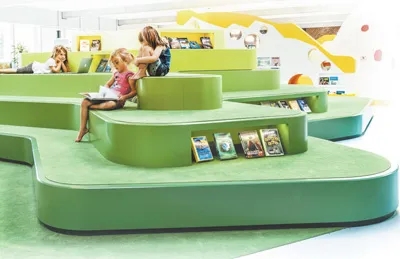
Children read books in a children's library in Billund, a town in Denmark.
In 1996, the United Nations Children's Fund (UNICEF) and the United Nations Human Settlements Programme (UN-Habitat) jointly launched the Child Friendly Cities Initiative, which aims to promote better integration of children's well-being into social development and urban governance all over the world.
With social development, many cities around the world are paying more attention to combining the child-friendly concept with their planning and governance. Examining urban development from the perspective of children reflects the emphasis on needs of children and bring more vitality and innovation to the city.
Berlin, Germany: Securing healthy and happy growth of children
In driving schools in Germany, coaches always urge the trainees to pay attention to the signs painted with patterns of children. This kind of sign indicates that there is a children's playground nearby, and vehicles' speed must be reduced to less than 5 km/h. If a trainee don't do that when seeing the sign in the driving test, he/she will fail. This is one of the key parts of the driving test. It not only reflects social attention on children's safety, but also the fact that in Germany there are many children's playgrounds which requires special signs to be set.
In Germany, providing more and better child-friendly infrastructure is the principal mission of building child-friendly urban communities. Children's playgrounds are an essential part of basic infrastructure.
According to the handbook on child-responsive urban planning by UNICEF, playgrounds and child-friendly public and green spaces can promote the development of children's cognitive abilities. These spaces create opportunities for interaction and establish an intimate connection between children, caregivers and the urban environment.
Berlin, for example, adopted a law in 1995, which defined children's playgrounds as an important part of the government's public services. The total population of Berlin is 3.64 million, and the construction area of children's amusement facilities is in line with the goal of 1 square meter per resident. The Berlin city government submits relevant construction progress reports to the city council every year. At present, governments at all levels in Berlin have created 1,858 public children's playgrounds in total, covering an area of 3.32 million square meters.
A children's playground in Berlin is not a large amusement park that requires tickets, but an open space in communities and street parks, paved with soft materials such as sand, and a sports facility with attractions like swings, slides, seesaws and climbing frames.
In order to ensure the safety of children, Germany published the first standard for public playground facilities as early as 1976. Since then, it has also specially formulated a regulation on the safety of equipment and ground for children's activity, which are strict on materials and strength of children's playground equipment as regards thickness, opening diameter, drop height and spacing of handrails. Even the sand covering the playground requires regular maintenance.
In Germany, population aging problem is prominent and noise management near playgrounds is very strict. It is inevitable that there are loud and disturbing noises around playgrounds. Many people have used legal means to protest against the construction of playgrounds and kindergartens. However, in order to protect the healthy and happy growth of children, the German government amended the Federal Pollution Control Law to remove children's noise from noise pollution, avoiding similar litigations and providing clear legal protection for the construction of children's amusement facilities and safeguarding children's amusement rights.
"We need to build a child-friendly country, and we are willing to accept all sides of children's nature," said the German federal government spokesperson Steffen Seibert.
The German child-friendly community association also plays an important role in the construction of playgrounds. As the planner and manager of child-friendly community building, the association often invites children and parents to participate in planning and give feedbacks to professional designers. The designers then provide different designs according to the conditions and needs of different blocks, and increase the diversity of the amusement facilities.
Various playgrounds have also spawned private platforms that provide services for children. In Berlin, many families with children often log in to a website, on which when they enter the block or a zip code and click "Search", a list of nearby playgrounds appears. The introduction of the facilities, applicable age and fun level rating are all on the website. Parents can find a playground they like for their children based on relevant information.
Apart from playgrounds, the website also provides information on sports venues, museums, libraries, planetariums, art workshops, and fun courses that are suitable for children. The website also collects information. Parents can use the RSS function to choose and participate in activities in which they are interested. During the COVID-19 pandemic lockdown period, the website also worked with private organizations to jointly develop a series of indoor activities, such as setting up a camping tent in the living room, painting watercolors in a bathtub, playing escape games with laser flashlights, making clay models, and planting flowers and herbs.
With the joint efforts of the government and the private sector, Berlin has achieved good results in the construction of a child-friendly environment. It's reflected in the slogan of the Berlin government — "Exploring Berlin with children is fun for the family! Berlin is a child-friendly city."
Billund, Denmark: Let children learn through play
This summer, Thomas, who was in the fifth grade of elementary school, went to the Danish town of Billund for vacation with his parents. He and his family lives in Brussels, Belgium. According to his mother, Thomas was not able to go to Billund on vacation last year due to the pandemic, which made him a bit unhappy. This year Thomas was finally allowed to stay there for a few weeks. "Billund is a children's paradise, and adults also find it interesting. Before the outbreak, our family went there every summer vacation," she said.
Billund, located on the Jutland Peninsula in southwestern Denmark, is the country's first child-friendly city. It used to be an unknown town with less than 300 permanent residents.
In the 1930s, the LEGO group was established in the city, and the world's first Legoland was built there in 1968. As the birthplace of LEGO brick, Billund now has the second largest airport in Denmark. The streets are full of bright and colorful walls that look like houses built with LEGO bricks. It attracts millions of tourists from all over the world every year.
Billund Mayor Ib Kristensen said in an interview that in Danish LEGO means "Play well". "Play well" is not only the goal of the Lego Group, but also to a large extent the development goal of Billund. In 2010, the Billund government decided to build the city into a "land for children," making it a paradise for children and letting them learn through fun and play.
"The world today is becoming more complex and the uncertainty is obviously increasing. It's difficult to solve the current and future problems based on experience. Only with imagination and creativity can we effectively deal with crises," Kristensen said, adding that scientific research shows that play is an important part for one's growth, which means learning through play can cultivate children's imagination and creativity.
Billund Children's Library, completed in 2016, aims to educate children through lively activities. The spacious and bright library has island, ocean, desert, mountain, rice field and other scenes. These unique designs are not only landscape installations, but also bookshelves, slides, cabins, tables and chairs. Here, children can get rid of the social norms of adult society, and explore the wonderful world. According to the designer, this place is like a paradise of knowledge, and is not only suitable for children; it can also inspire the childlike innocence hidden deeply in the hearts of people of all ages, and stimulate adults to learn and examine the world from the perspective of children through an interesting and diverse space.
In Billund, there are many places where children can have fun. There is a 45-hectare Legoland as well as water parks, wildlife parks, and sculpture parks. "If you want to become a 'land for children,' you must have sufficiently diverse and differentiated amusement facilities," Kristensen said. "In the past 10 years, Billund has expanded and added a series of children's activity spaces and facilities, especially outdoor facilities, which play a very important role for children to get close to nature."
"In Billund, although children can play well, it is not enough to make this city a 'land for children'," said Kristensen, noting that Billund gives children equal rights of participation in urban planning and decision-making, believing that they, like adults, have the ability to express their views. In the eyes of the Billund people, children are not only important consumer groups, but also the masters of the city.
In order to emphasize children's status as the masters of the city, the Billund government, the media and childcare bodies regularly invite some children to serve as "mayor," "editor-in-chief" or "institution director" for a day, and listen to their opinions in decision-making. The city has also established a group composed of nine representatives of elementary and middle school students who participate in policy making from a child's perspective. "As a 'land for children,' Billund does not make decisions for children, but allows children to make decisions. Children have the right to make decisions related to urban planning," Kristensen said.
In 2019, a children's representative of Billund suggested that there are 10 areas in the city that are not very safe for children to walk alone, and proposed that the government should improve work in these areas. The government adopted the proposal and made road safety a priority issue of the year. In another case, there is a tunnel built at the entrance of a school in the city. The original intention of opening the tunnel was to avoid traffic congestion and ensure students' safety. However, many young children were not willing to use the tunnel because of its wall paintings and the echoes in the tunnel made them feel uneasy. According to children representatives' proposals, the city's government painted patterns that children liked on the walls of the tunnel and modified the echo effect.
Singapore: Create diversity for children's development
Cheng and his wife from Singapore have worked and lived abroad for many years. After their children, they decided to move back to Singapore. In Cheng's view, life in Singapore is very convenient for families with children. In most communities, apart from nurseries and kindergartens, there are public facilities such as parks, playgrounds and museums. Providing children with a healthy, safe and pleasant environment has become an important consideration for urban development in Singapore.
In the HDB flats of Singapore, all the apartments have entertainment spaces for three generations. Generally, the ground floor is an open public space for residents to use flexibly. Playing hide-and-seek and skateboarding, children have safe and sufficient space for activities and enjoy a carefree childhood; parents and elderly people can watch the children while chatting. In the community, there are open-air children's playgrounds with fitness corners. Parents, seniors and children share the same space, which helps develop children's sense of responsibility and understanding of others.
In order to create opportunities for children to play in nature, in 2019 the national parks administration of Singapore built a "natural amusement park" specifically for preschoolers. Facilities in the park are made of materials like logs, sand and bamboo, instead of common ones such as plastic slides. This design concept allows children to have more intimate contact with nature and stimulates their love for nature and their creativity. In the next few years, the administration plans to build more similar natural amusement parks.
Besides urban and community space design, Singapore also focuses on comprehensive measures such as policies, laws, education, medical care, and social welfare to create a healthy and safe environment for children.
Singapore has promulgated a law on children and youth, and relevant departments will intervene when children are abused or their rights and interests are neglected according to the law. The country has established a professional child protection system. The Ministry of Social and Family Development of Singapore is the main responsible agency, working closely with the police, school, hospital, social service agency and court to safeguard children's interests. Community organizations such as family service centers and child protection experts' centers have provided support for the protection of children. For example, due to emotional and financial stress some families are unable to take good care of their children, the family service centers will provide early intervention, such as financial support and counseling services to help parents better cope with stress and take care of their children.
High-quality medical resources and health services provide an important guarantee for the health of children. Children can be vaccinated for free, and children under the age of 6 can receive a physical test for free. After entering the primary school, the Singapore government assigns doctors and nurses to each school to carry out free checkups every year. In addition, the Health Promotion Board of Singapore has cooperated with schools to launch various plans to promote the physical and mental health of children.
From national legislation to policy support, from investment in children's facilities to creating a good environment, Singapore prioritizes the development of children and makes various efforts to provide a better and diversified growth space.
